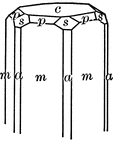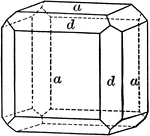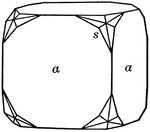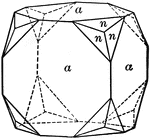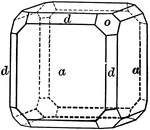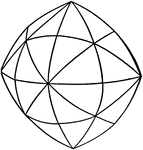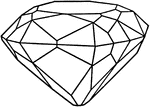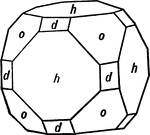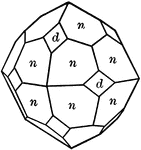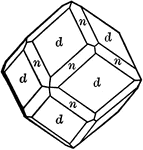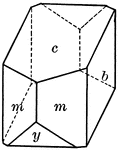This science ClipArt gallery offers 324 illustrations of crystals of numerous minerals. These crystalline minerals are created through natural processes, and so often times there are numerous crystal shapes for any given mineral (polycrystalline materials).
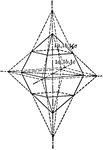
Sulphur crystal
"The forms present upon it are two pyramids of different slope but each intersecting all three of the…
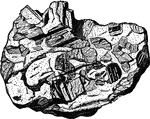
Crystalline Aggregate
A Crystalline Aggregate is mass of crystal grains, devoid of their characteristic forms and closely…
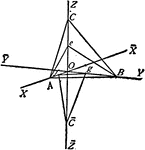
Crystallographic Axes of Reference
"...take any three edges formed by the intersection of three faces of a crystal. These axes are called…
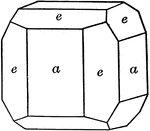
Cube and pyritohedron
"A combination of cube and pyritohedron, in which it will be noted that the faces of the pyritohedron…
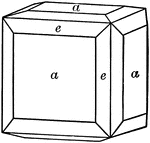
Cube and tetrahexahedron
"A cube with its edges beveled by the faces of a tetrahexahedron." — Ford, 1912
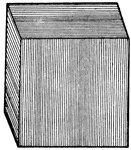
Cube of Iron Pyrite
Cubes of Iron Pyrites frequently show a striation of their planes in one direction, which is perpendicular…

Curvature of Crystal Planes (Diamond)
Curvature of crystal planes is quite a constant property of some substances. It may be due to a very…
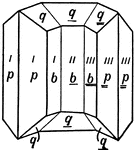
Cyclic Twinning
This crystal of Aragonite shows a method of twinning where the twinning plane may change its direction,…
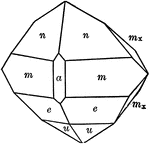
Datolite
"Monoclinic. Habit varied. Crystals usually nearly equidimensional in the three axial directions and…
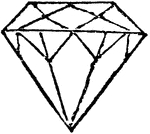
Diamond
"Pure crystalline carbon, the hardest substance known, possessing great lustre owing to its great refracting…

Diamond Cut
The diamond is cut to show the stone's brilliance, creating different parts to the cut: table, crown,…

Square Cut Diamonds
Various types of square cut diamonds. Top row: Old square cut diamonds. Bottom row: English square cut…

Diopside
Diopside is a monoclinic pyroxene mineral with composition MgCaSi2O6. It forms complete solid solution…

Dioptase
Dioptase is an intense emerald-green to bluish-green copper cyclosilicate mineral. It is transparent…
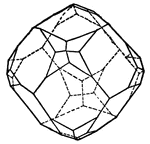
Dodecahedron
Crystal; This form is a combination of an icositetrahedron and a rhombic dodecahedron, where the faces…
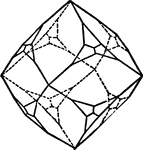
Dodecahedron
Crystal; This form is a combination of an icositetrahedron and a rhombic dodecahedron, where the faces…
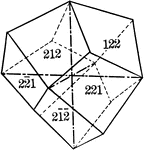
Deltoid dodecahedron
"The faces of the deltoid dodecahedron correspond to one-half those of the trisoctahedron." —…
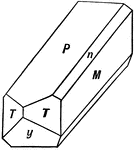
Elongation in the Direction of the Clinodiagonal Axis
In cases where the basal pinacoid is fixed by some physical property like cleavage, the elongation is…

Elongation in the Direction of the Orthogonal Axis
In some cases, the elongation of a crystal may be in the direction of the orthogonal axis, whose position…

Enantimorphous Crystals of Tartaric Acid
"...shows two crystals of tartaric acid, a a right-handed crystal of dextro-tartaric acid, and b a left-handed…

Epidote
"Monoclinic. Crystals are often much elongated parallel to the ortho-axis with a prominent development…
![Ferrocolumbite, also called niobite, niobite-tantalite, columbate and columbite [(Fe, Mn)(Nb, Ta)2O6] is a black mineral that is an ore of niobium and tantalum. It has a submetallic luster and a high specific gravity and is a niobate of iron and manganese, containing tantalate of iron. This mineral was first found at Haddam, Middlesex County, Connecticut in New England, USA. It forms a series with the tantalum-dominant analogue Ferrotantalite and one with the manganese-dominant analogue Manganocolumbite.](https://etc.usf.edu/clipart/58700/58788/58788_ferrocolumbi_mth.gif)
Ferrocolumbite
Ferrocolumbite, also called niobite, niobite-tantalite, columbate and columbite [(Fe, Mn)(Nb, Ta)2O6]…
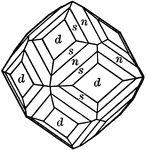
Garnet
"Isometric. Common forms dodecahedron amd trapezohedron, often in combination. Hexoctahedron observed…
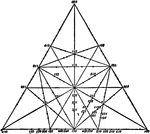
Gnomonic Projection of a Cubic Crystal
"Here the plane of projection is tangent to the sphere, and normals to all the faces are drawn fro mthe…

Goethite
Goethite is a mineral composed of an iron hydrate crystallizing in soil and other low temperature environments.

Gold
Gold crystals of the form 3O3, {311}, sometimes resemble combinations of the rhombohedron and scalenohedron.
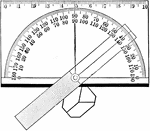
Contact Goniometer
"An important part of the study of crystallography consists in the measuring and classifying of the…
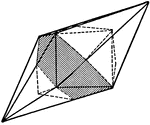
Green Fluorspar from Saxony
Certain crystals of green fluorspar from Saxony, showing the form ∞ 03, {310}, have one half of their…
Gypsum
"Monoclinic. Crystals usually tabular parallel to clinopinacoid; in diamond-shaped crystals with edges…
Gypsum
"Monoclinic. Crystals usually tabular parallel to clinopinacoid; in diamond-shaped crystals with edges…

Gypsum (Twinning)
This image represents a twin of the monoclinic mineral Gypsum. Its twinning plane is the orthopinacoid.

Hematite
"Hexagonal-rhombohedral. Crystals usually thick to thin tabular. Basal planes prominent, often showing…
Hematite
"Hexagonal-rhombohedral. Crystals usually thick to thin tabular. Basal planes prominent, often showing…
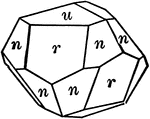
Hematite
"Hexagonal-rhombohedral. Crystals usually thick to thin tabular. Basal planes prominent, often showing…
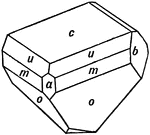
Hemihedral Crystal of Pyroxene
This image shows a hemihedral crystal of pyroxene, whose forms are (c), (b), (a), (m), (o), and (u).
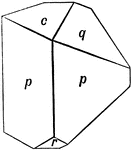
Hemimorphism in the Direction of the Axis of Symmetry
This figure shows hemimorphism in the direction of the axis of symmetry on a crystal of Pentacid Alcohol…

Hemimorphism in the Direction of the Vertical Axis
Hemimorphism in the direction of the vertical axis has been observed on crystals of the tetragonal salt,…
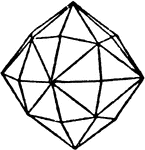
Hexakis Octahedron
A disdyakis dodecahedron, or hexakis octahedron, is a Catalan solid and the dual to the Archimedean…
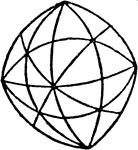
Hexakis Octahedron
A disdyakis dodecahedron, or hexakis octahedron, is a Catalan solid and the dual to the Archimedean…

Hexoctahedron
This form is bounded by forty-eight similar scalene triangles. Its solid angles are of three kinds:…

Hornblende
Hornblende is a complex inosilicate series of minerals. Hornblende is not a recognized mineral in its…
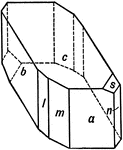
Hydrous Copper Sulphate
This figure reproduces a crystal of Hydrous Copper Sulphate whose forms are (c), (a), (b), (n), (m),…
